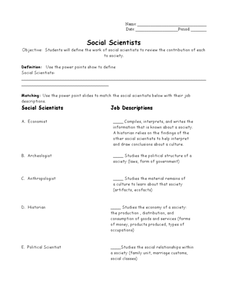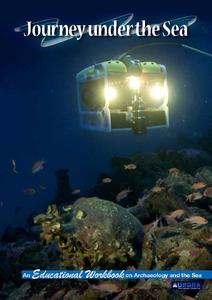Museum of Tolerance
Artifact Research Activity
Artifacts give us the privilege of learning about the past, may it be family, culture, or traditions. Here, class members learn about their family's past with the help of an artifact, or family heirloom. Once an artifact is...
Chicago History Museum
Reading Artifacts
History detectives put their keen observation skills to the test as they closely examine artifacts. Drawing on visual and tactile clues, they formulate a theory about who done it, or in this case who made it, why, and for what...
US House of Representatives
Objects in Time
What is the role artifacts play in the study of past events and people? As part of an examination of the careers and contributions of women in Congress from 1917 to 2006, groups examine artifacts that symbolize each woman.
National Park Service
The Power of Remembrance
On every July 4th, we watch fireworks and celebrate our independence, but how is the history of the American Revolution preserved? Four social studies instructional activity guide learners through different memorials, commemorative...
Reading Through History
The Slaughterhouse Cases
Do modern citizens interpret the Fourteenth Amendment the way it was intended? Scholars study the Slaughterhouse Cases to see how judges interpreted the amendment in the 1800s. Following the reading on the subject, they answer...
Smithsonian Institution
Ceramica de los Ancestros
Scholars join a field expedition team to unearth a plethora of treasures from Central America. Artifacts listed in alphabetical order come with an informational blurb and a picture designed for participants to color. Activity pages...
British Museum
The Kingdom of Benin
Discover the society of Benin through analysis of several artifacts and rich primary source materials. Here you'll find worksheets on topics as the work of Benin craftsmen, the influence of the all-powerful Oba, explanations for the...
Curated OER
Ancient Babylon
Authenticate an ancient civilizations study by having historians analyze primary source artifacts. After examining an image of a Babylonian king votive statue, pupils read a short background context. They then answer 3 questions based on...
Wish for the Future
Wish for the Future
What would be your class's ideal world 30 years in the future? What about 100 years? Use a series of activities to discuss globalization, sustainability, scientific contributions to society, and the global community of which your...
Curated OER
Artifact Classification
In this artifact classification worksheet, students are given a list of key terms and two activity sheets about classifying artifacts of the Pee Dee culture. Students analyze artifacts and group them to answer questions on the...
Eastconn
Learning to Analyze Political Cartoons with Lincoln as a Case Study
Discover the five main elements political cartoonists use—symbolism, captioning and labels, analogy, irony, and exaggeration—to convey their point of view.
Museum of Tolerance
Quilt Activity
After completing the first five lessons from the series, scholars assemble their quilt pieces to create a family history quilt. They then rate their experience of learning about their families by conducting interviews, creating family...
Curated OER
Worksheet for Analysis of an Artifact
In this primary source analysis worksheet, students respond to 20 short answer questions that require them to analyze an artifact of their choice.
National Park Service
Maltese Cross Cabin
The Maltese Cross Cabin, a frontier residence of Theodore Roosevelt, is a time capsule that commemorates Roosevelt's time in the Dakota territory. An explanatory video and response guide takes students on a virtual tour of the wooden...
Curated OER
Artifact Analysis Worksheet
In this artifact analysis worksheet, students decipher what type of artifact they have based on a complete list of criteria. Students then answer multiple questions based on their discoveries.
Curated OER
Social Scientists
In this social scientist worksheet, students respond to 10 matching and short answer questions about the work of economists, archaeologists, anthropologists, historians, and political scientists.
Curated OER
Ancient Egypt Artifacts: Birmingham Museums and Art Gallery Learning and Outreach
In this Egyptian artifacts learning exercise, students study photographs and information from the Birmingham Museum. There are 23 pages, each with a color photograph of an actual artifact and background information. There are no questions.
Curated OER
Study techniques
In this study techniques worksheet, students answer multiple choice questions about chronology, osteology, and more. Students complete 4 questions.
Aurora Trust
Journey Under the Sea
Discover the interesting world of maritime archaeology and explorations under the sea with this nice set of worksheets, which cover such topics as search tools and techniques of underwater archaeology, carbon dating,...
Reading Through History
The March on Washington
How does marching get a point across to the government? Teach pupils about civics, human rights, and freedom of speech using the resource about the March on Washington. After reading, learners complete multiple-choice and short-answer...
Calisphere
The 6 C's of Primary Source Analysis
Arm your class members with the six C's of primary source analysis—content, citation, context, connections, communication, and conclusions—and help them to establish a solid system for analyzing historical sources of...
Curated OER
Artifact Activity
In this Richard Smallbroke and Richard Small learning exercise, students respond to 5 fill in the blank questions correctly sorting and labeling the objects that belong to a rich gentleman and those that belong to a poor man.
Curated OER
The Story Within Worksheet
In this reading artifacts activity, students imagine they have arrived on earth from another galaxy and write a description of an object they have found. Function, form , and meaning of the object are revealed when students answer 6...
Curated OER
Photograph / Special Object Worksheet
In this fieldwork application activity, students utilize a photo or object that they brought to class to study. Then they follow the directions on the activity and interview a classmate, using the 13 questions, about his or her photo or...























